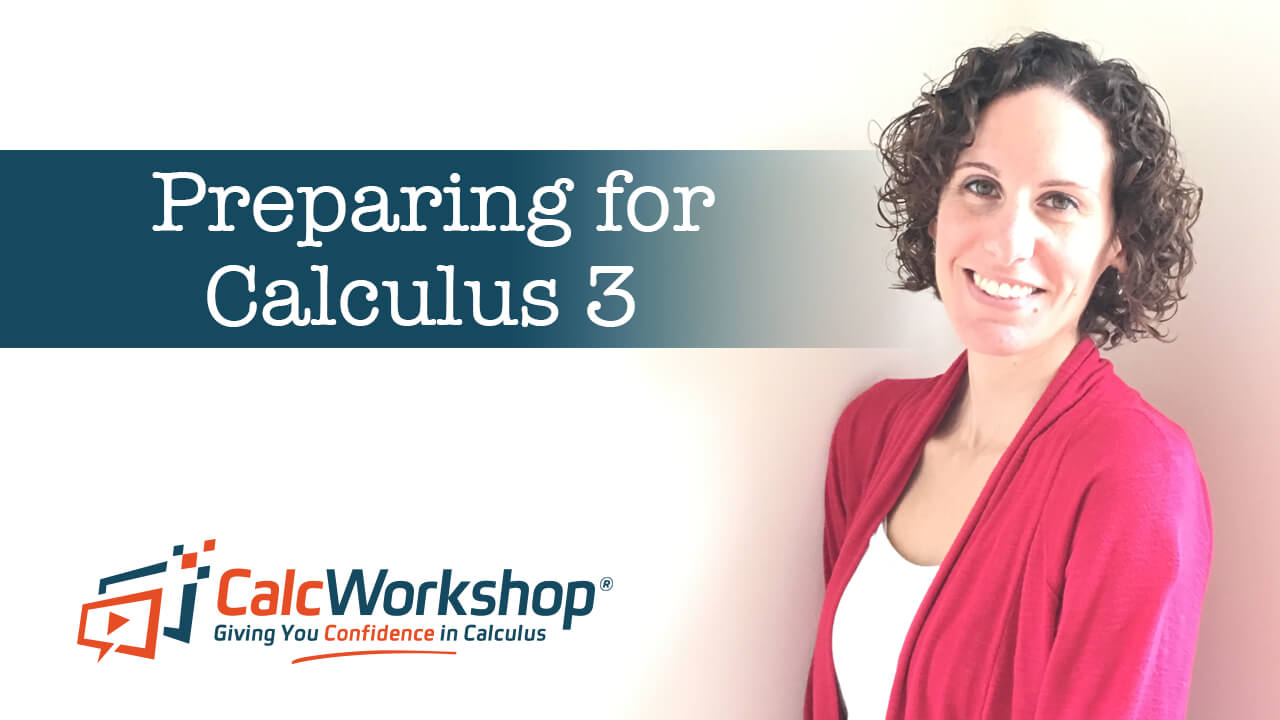You’ve just finished Calculus 2 and now you are about to embark on the exciting journey of Calculus 3!

Jenn, Founder Calcworkshop®, 15+ Years Experience (Licensed & Certified Teacher)
Calculus 3, also called Multivariable Calculus or Multivariate expands upon your knowledge of single-variable calculus and applies it to the 3D world.
In other words, we will be exploring functions of two variables which are described in the three-dimensional coordinate systems.
So the question is…
…Are you ready for Calculus 3?
Most importantly, Calc 3 encompasses limits, derivatives, and integrals so all of these concepts that you previously learned in Calc 1 and Calc 2.
So that means you already have all the math skills necessary to succeed.
Now we just need to remember some key concepts, and possibly brush up on some ideas we haven’t seen in a while.
First, you will begin by learning about vectors and the geometry of space, which deals with writing equations of lines and planes, operations with vectors, and quadric surfaces.
What are quadric surfaces, you may ask?
A quadric surface is the graph of a second-degree equation in three variables. But this just sounds scary, doesn’t it?
All this means is that we are going to take our beloved two-dimensional conic sections from precalculus and translate them into the three-dimensional coordinate system.
Consequently, it is really important to remember and review how to identify conic sections such as:
- Circles
- Ellipses
- Parabolas
- Hyperbolas
Because they will play a vital role in how we identify and graph quadric surfaces such as cylinders, ellipsoids, paraboloids, spheres, and hyperboloids.
Next up in your journey through Calculus 3 is to learn how to differentiate and antidifferentiate vector functions and discover how they describe motion in space – velocity and acceleration.
Afterward, you will learn how to find:
- Partial Derivatives
- Gradient Vectors
- Directional Derivatives
Additionally, you will determine how to evaluate limits of multivariable functions, as well as finding extrema (maximums and minimums) of various surfaces.
So what do you need to know to be successful?
Basic limit and derivative rules!
You will have to simplify limits of indeterminate forms, take derivatives using the power, product, and quotient rules. Additionally, you’ll use the chain rule for polynomial, rational and trigonometric functions.
For the remainder of the course, you will focus on integration, in particular, you will be learning how to evaluate multiple integrals to find area, volume, and work done by a force field or the rate of fluid flow across a surface.
Consequently, you will utilize such techniques as Riemann Sums, U-Substitution, Integration by Parts, and Trigonometric Integration.
While this may sound scary, I find that most students grasp these ideas pretty quickly with some practice.
But what really helps propel you to greater success is having a good understanding of polar coordinates and a basic concept of work.
Why?
Because you will quickly find that some integrals are just to hard to calculate by hand in Cartesian (rectangular) coordinates.
Therefore, we need to use a change of variables so we can integrate using either cylindrical (polar) or spherical coordinates, or even parametric form. And Vector Calculus, which tends to be the last chapter for Calculus 3, deals with work on, in, and around a surface which will predominately involve polar coordinates as well.
So how do you get on the fast track?
Remembering how to convert from polar to rectangular and vice versa, as well as how to handle parametric functions!
Thankfully, our Calculus 3 Readiness Test has everything you need to give you a taste of what to expect, review all those important concepts that you will be expected to know and give you the confidence you need to succeed!
Pre-Test & Answer Key
- Calculus 3 Assessment Test: Practice your skills as you get ready for Multivariable Calculus. This readiness test includes 22 practice problems.
- Calculus 3 Assessment Key: Check your answers and determine your areas of strength or weakness.
Video Solutions
1 hr 20 min
- Introduction to Video: Are you Ready for Calculus 3?
- 00:00:00 – For #1-2: Determine Discontinuity and Evaluate the Limit
- 00:06:01 – For #3-6: Evaluate each Limit
- 00:18:34 – For #7-9: Find the derivative of each function
- 00:25:30 – For #10: Find all local and absolute extrema for the function
- 00:31:48 – For #11-12: Evaluate the Integral
- 00:38:36 – For #13-14: Evaluate the Integral
- 00:44:27 – For #15: Approximate using Right and Left Riemann Sums and the Trapezoidal Sum
- 00:51:57 – For #16-17: Find the Area of the region and the Length of the Curve
- 00:58:01 – For #18: Find the Volume of the solid generated
- 01:03:22 – For #19: Identify the Conic Section
- 01:08:35 – For #20-21: Convert from Rectangular to Polar Form and from Polar to Rectangular Form
- 01:15:22 – For #22: Eliminate the Parameter and write the equation in Rectangular Form
Get access to all the courses and over 450 HD videos with your subscription
Monthly and Yearly Plans Available
Still wondering if CalcWorkshop is right for you?
Take a Tour and find out how a membership can take the struggle out of learning math.